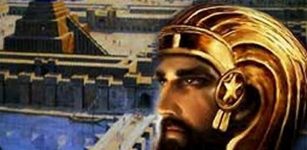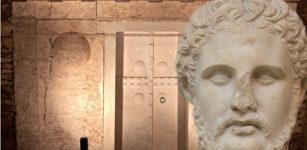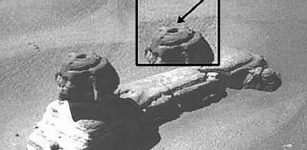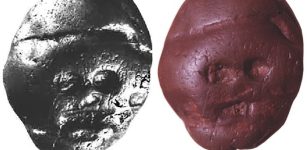‘Altar Of Twelve Gods’ At Gabii, Italy Was Once An Important Ancient Place
A. Sutherland - AncientPages.com - 'Altar of Twelve Gods', also called the Sanctuary of the Twelve Gods was found at Gabii, Italy.
This valuable piece of sculpture represents the twelve gods of the Roman pantheon.
Image credit: Jastrow - Public Domain
Its purpose is unknown, maybe it functioned as the brink of a well or a Zodiac altar. The altar became the zero point from which distances to Athens were calculated. It also functioned as a place of supplication and refuge in 519 BC, when the Plataeans came to Athens seeking protection from Thebes.
Herodotus mentioned an 'Altar of twelve gods', according to Herodotus-, while "the Athenians were making sacrifices to the twelve gods, they (the Plataeans) sat at the altar as suppliants and put themselves under protection."
Currently visible remains of the Altar in the Agora of Athens. Image credit: Tomisti - CC BY SA 4.0
In 431 BC, as the result of accusations of the misappropriation of public funds involving Pericles and the sculptor Phidias, some of Phidias's assistants sat as suppliants at the altar.
Shortly before his execution at Athens (in about 355 BC), the Athenian general Callistratus took refuge there as well.
The altar is adorned with bust of the twelve principal divinities of the Greeks and Romans, namely Jupiter, Minerva, Apollo, Juno, Neptune, Vulcan, Mercury, Vesta, Ceres, Diana, Mars and Venus with Cupid behind her shoulder.
They are adorned with the twelve signs of the zodiac, and with symbols of the divinity supposed to preside over the month, which each sign indicates.
Altar of the twelve gods. Original in Louvre, cast in Pushkin museum. Use unknown: maybe the brink of a well or an Zodiac altar. The object represents the twelve gods of the Roman pantheon, each identified by an attribute: Venus and Mars linked by Cupid, Jupiter and a lightning bolt, Minerva wearing a helmet, Apollo, Juno and her sceptre, Neptune and his trident, Vulcan and his sceptre, Mercury and his caduceus, Vesta, Diana and her quiver and Ceres. Marble, found in Gabii (Italy), 1st century CE. Image source - Louvre Museu. Image credit: shakko - CC BY-SA 3.0
The Altar of the twelve gods was once one of the more distinguished precincts in the Athenian Agora. Today very little meets the eye. Nearly nine-tenths lies concealed beneath the Athens-Piraeus Electric Railway.
It was excavated by G. Hamilton in 1792 at Gabii an ancient city of Latium, located 18 km (11 mi) due east of Rome, Italy. The identification of the monument was made possible by the discovery of an inscription on a marble statue base found in the area of the altar. The inscription reads: “Leagros, son of Glaukon, dedicated (the statue) to the Twelve Gods”.
Leagros was an Athenian general after 480 BC and was killed in 461 BC during an abortive campaign in Thrace.
This piece of art was purchased for the Louvre by Napoleon. On top within the ring of divine heads, there is a shallow sinking with narrow slits at the bottom used to a toothed metal plague, now lost.
Written by – A. Sutherland - AncientPages.com Senior Staff Writer
Updated on March 21. 2023
Copyright © AncientPages.com All rights reserved. This material may not be published, broadcast, rewritten or redistributed in whole or part without the express written permission of AncientPages.com
Expand for referencesReferences:
The Sanctuary of the Twelve Gods in the Athenian Agora: A revised view
C.R. Long, The Twelve Gods of Greece and Rome
More From Ancient Pages
-
 Legacy Of The Ancients: Cyrus The Great Cylinder – The Charter Of Human Rights
Featured Stories | Feb 17, 2014
Legacy Of The Ancients: Cyrus The Great Cylinder – The Charter Of Human Rights
Featured Stories | Feb 17, 2014 -
 The Wild Hunt And The Danger Of Seeing The Phantom Army Of Odin
Featured Stories | Dec 8, 2024
The Wild Hunt And The Danger Of Seeing The Phantom Army Of Odin
Featured Stories | Dec 8, 2024 -
 Royal Tombs Of Alexander The Great’s Family At Vergina, Greece Finally Identified
Archaeology | Jan 31, 2024
Royal Tombs Of Alexander The Great’s Family At Vergina, Greece Finally Identified
Archaeology | Jan 31, 2024 -
 Hiawatha And The Legendary Great Peacemaker – Native American Heroes Who Founded The League Of The Iroquois
Featured Stories | Feb 25, 2019
Hiawatha And The Legendary Great Peacemaker – Native American Heroes Who Founded The League Of The Iroquois
Featured Stories | Feb 25, 2019 -
 Stone Water Well Dated To Sassanid Era (224-651 CE) Unearthed In Isfahan Hills, Iran
Archaeology | Jun 26, 2020
Stone Water Well Dated To Sassanid Era (224-651 CE) Unearthed In Isfahan Hills, Iran
Archaeology | Jun 26, 2020 -
 13,000-Year-Old Human Footprints Discovered In Canada
Archaeology | Mar 30, 2018
13,000-Year-Old Human Footprints Discovered In Canada
Archaeology | Mar 30, 2018 -
 2,500-Year-Old Olmec Related Mexican Cave Paintings Are Now Restored And Protected
Civilizations | Sep 18, 2015
2,500-Year-Old Olmec Related Mexican Cave Paintings Are Now Restored And Protected
Civilizations | Sep 18, 2015 -
 Chachapoyas Culture: More Than 100 Archaeological Structures Discovered At Gran Pajatén, Peru
Archaeology | Jun 3, 2025
Chachapoyas Culture: More Than 100 Archaeological Structures Discovered At Gran Pajatén, Peru
Archaeology | Jun 3, 2025 -
 Genetic Testing To Trace The Bloodline Of Leonardo da Vinci
DNA | May 26, 2025
Genetic Testing To Trace The Bloodline Of Leonardo da Vinci
DNA | May 26, 2025 -
 Head Of The Great Sphinx Was Changed – It’s The Gateway To A Secret Underground City– Historians Suggest
Featured Stories | Jan 20, 2018
Head Of The Great Sphinx Was Changed – It’s The Gateway To A Secret Underground City– Historians Suggest
Featured Stories | Jan 20, 2018 -
 More Than 60,000 Ancient Maya Structures Obscured By Inaccessible Forest Revealed By LIDAR
Archaeology | Sep 29, 2018
More Than 60,000 Ancient Maya Structures Obscured By Inaccessible Forest Revealed By LIDAR
Archaeology | Sep 29, 2018 -
 12 Ancient Myths, Legends And Biblical Stories Confirmed By Modern Science
Featured Stories | Apr 22, 2017
12 Ancient Myths, Legends And Biblical Stories Confirmed By Modern Science
Featured Stories | Apr 22, 2017 -
 Engraved Trees Are Living Records Capturing The Rich History And Traditions Of The Sámi People
Archaeology | Nov 21, 2024
Engraved Trees Are Living Records Capturing The Rich History And Traditions Of The Sámi People
Archaeology | Nov 21, 2024 -
 Mysterious Location Of The Amazing Land Of Punt – Can This Puzzle Be Solved One Day?
Featured Stories | Jul 18, 2016
Mysterious Location Of The Amazing Land Of Punt – Can This Puzzle Be Solved One Day?
Featured Stories | Jul 18, 2016 -
 Why Are Manuports Like The Makapansgat Cobble Interesting Archaeological Artifacts?
Artifacts | Mar 15, 2024
Why Are Manuports Like The Makapansgat Cobble Interesting Archaeological Artifacts?
Artifacts | Mar 15, 2024 -
 Perfectly Preserved 10,500-Year-Old Basket Found In Muraba’at Cave
Archaeology | Mar 18, 2021
Perfectly Preserved 10,500-Year-Old Basket Found In Muraba’at Cave
Archaeology | Mar 18, 2021 -
 What Rights Did Viking Women Have?
Ancient History Facts | Mar 19, 2021
What Rights Did Viking Women Have?
Ancient History Facts | Mar 19, 2021 -
 Trung Sisters Of Vietnam: National Heroines That Stood Against Cruel Chinese Occupation Of Their Country
Featured Stories | May 25, 2025
Trung Sisters Of Vietnam: National Heroines That Stood Against Cruel Chinese Occupation Of Their Country
Featured Stories | May 25, 2025 -
 Psychedelic Blue Lotus Of Egypt – A Misunderstood Ancient Mystery?
Archaeoastronomy | Mar 19, 2025
Psychedelic Blue Lotus Of Egypt – A Misunderstood Ancient Mystery?
Archaeoastronomy | Mar 19, 2025 -
 Pictograms: First Written Accounts Of Earthquakes In Pre-Hispanic Mexico
Archaeology | Aug 27, 2021
Pictograms: First Written Accounts Of Earthquakes In Pre-Hispanic Mexico
Archaeology | Aug 27, 2021



